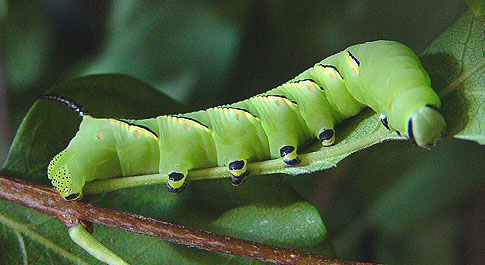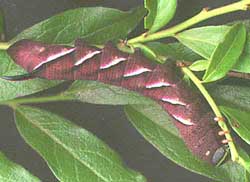Prince County, western Prince Edward Island, Canada
Sphingidae

Sphinx kalmiae larva, courtesy of Tim Dyson.
For care of "found larvae/caterpillars" visit Manduca sexta larva, central Texas, August 21, 2008, Trina Woodall.
This page is designed and maintained by Bill Oehlke of Montague, Kings County, Prince Edward Island, Canada.
It is hoped
that this checklist, with the thumbnails and notes, will help you
quickly identify the caterpillars (larvae) you are likely to encounter.
A "WO" after the species name indicates that
I (William Oehlke) have confirmed reports of this species in Kings county.
Please help me develop this list with improved, documented accuracy by
sending sightings (species, date, location), preferably with an
electronic image, via email to
Bill Oehlke.
Sphinginae subfamily
Sphingini tribe:
 |
Note the pinkish-orange tail, spiracles outlined in red and the cream
stripes on the head.
The dramatic color change from the dorsal
yellow-green to the lateral light greyish-blue is not always
as intense as in this image.
|
 |
This caterpillar is also without the anal horn and feeds on pines.
The long stripes and reddish brown afford great camouflage.
|
 |
Larvae hide in the day and feed primarily on cherry, plum, and apple
at night. Larvae have been found on Amelanchier nantuckensis
in Massachusetts and have been reared to pupation in Michigan on
Prunus serotina. Note purple oblique lines.
|
 |
In the final instar, the black on the head, lateral lines, horn and on abdominal
legs is diagnostic. Larvae feed primarily on lilac and fringe.
|
 |
If you have blueberries in the woods, then you probably have the
Poecila Sphinx.
The green form is more common.
|
Smerinthini Tribe:
 |
Pachysphinx modesta
WO,
the Modest Sphinx or Poplar Sphinx
Larvae of this moth are fond
of poplars and
willows and is most likely present.
|
 |
Larvae accept willows, birches, and cherries.
I have also found them in the wild on oak in eastern Canada.
|
 |
Wild cherry species are the favorites as larval foodplants, but eggs
will also be deposited on birches and other forest trees.
There are varying degrees in the amount of red markings along the sides.
|
 |
Larvae feed upon many forest trees including birches and cherries,
but are expecially fond of poplars and willows. Red markings on sides
vary greatly from specimen to specimen.
|
 |
Smerinthus cerisyi
WO,
Cerisy's Sphinx;
Cerisyi larvae greatly resemble modesta larvae, both being pale
green, with granular skin, pale lateral diagonal lines, faint red
spiracular circles, and very pale longitudinal lines running from the
head to a more pronounced anal diagonal line.
Larvae have green heads bounded dorsally with a pale yellow
inverted "V".
|
Macroglossinae subfamily
Dilophonotini tribe:
 |
Hemaris thysbe
WO, the Hummingbird Clearwing
There is also an orangey-pink prepupal form. The lateral line runs
from S1 to the blue horn.
Hemaris thysbe larvae feed on viburnum and related plants.
|
Macroglossini tribe:
 |
In additon to Virginia creeper larvae accept Grape (Vitis),
ampelopsis (Ampelopsis), and cayenne pepper (Capsicum).
Larvae are green until the final instar.
|
 |
Larvae feed on Azalea and Viburnum and progress very rapidly. The
larva to the left on Viburnum cassinoides is getting ready to
pupate. Color change from green to light burgundy-brown indicates
pupation is imminent.
|
 |
Hyles gallii
WO, the Bedstraw Hawk Moth
or Gallium Sphinx
Larvae come in black and in brown forms and often feed on
Epilobium (fireweed).
|
|
|
Enjoy some of nature's wonderments, giant silk moth cocoons.
These cocoons are for sale winter and fall. Beautiful Saturniidae moths will emerge the following spring and summer.
Read Actias luna rearing article. Additional online help available.
Use your browser "Back" button to return to the previous page.
This page is brought to you by
Bill Oehlke and the
WLSS. Pages are on space rented from Bizland. If you would like
to become a "Patron of the Sphingidae Site", contact Bill.
Please send sightings/images to Bill. I will do my best to respond to
requests for identification help.
 | 
Show appreciation for this site by clicking on flashing butterfly to the left.
The link will take you to a page with links to many insect sites. |

